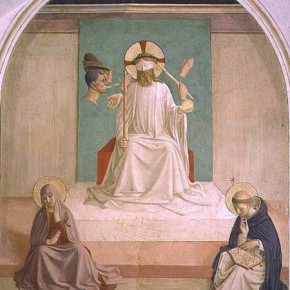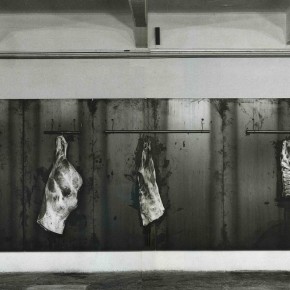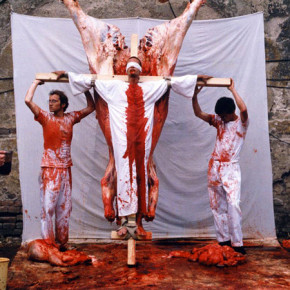No Life Lost, a solo exhibition by artist Berlinde De Bruyckere at Hauser and Wirth, New York, is a poetic reflection on time, space, and mortality. The title is a remark, a hint, something that may initially feel contradictory to the work that is presented. In actuality, no life was lost in the making of De Bruyckere’s work. Well, at one point life was lost. It was lost like that of a dream becoming a memory of something which may or may not have happened. At one time, the hides forming the sculptures in the exhibition housed bodies —muscles, veins, bones, life— however those bodies are not the ones we witness in unnatural positions at Hauser and Wirth. It is here, in this detail where art has enveloped the space where life once dwelled.
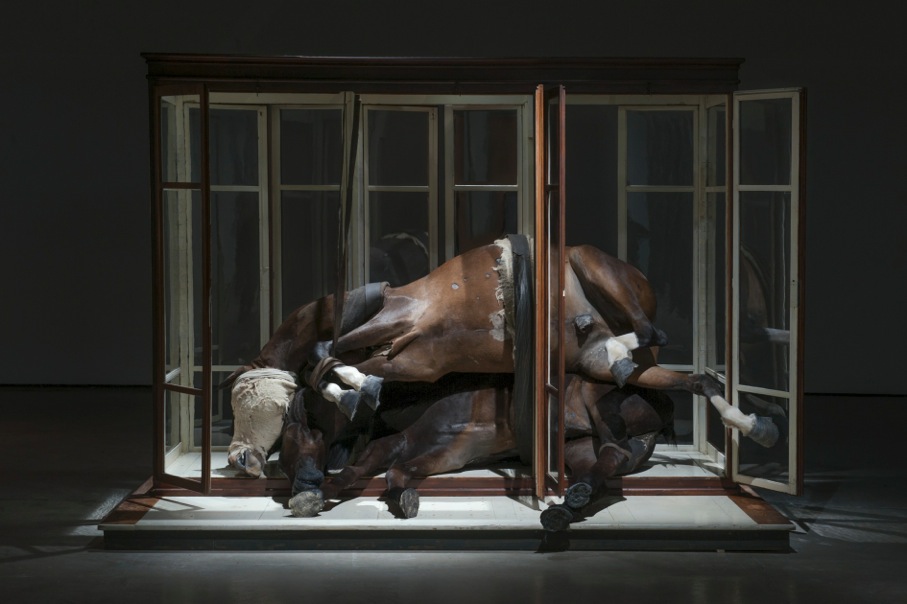
Berlinde De Bruyckere, No Life Lost II, Installation view, Hauser and Wirth, Image courtesy of the gallery, 2016
Berlinde De Bruyckere uses various materials in her sculptures in the same way a painter uses colors on a canvas. Her mediums are sometimes organic and need to be treated as such. There is an unspoken delicate nature to the animal hides used, similar to what would be associated with lace. Rather than transparent or easily torn, the hide is molded and malleable, in this case assuming life or what appears to be death. De Bruyckere piles bodies of horses in a glass encasements in the same way one might use a similar enclosure as a china closet. These animals are fabrications —sculptural forms that assume to be bodies— awkwardly sprawled in unlikely spaces, faces covered in wool giving them a mummified appearance. When speaking to the artist, one will learn that horses are actually much more relaxed when their eyes are covered, experiencing a moment of zen rather than panic. However, the result is not one of zen, or is it? When looking at art, we bring with us, our past experiences with not only other art and artists, but also with life (and death) in general. This very human way of reading visual language is both a flaw and advantageous. As a disadvantage, artists such as De Bruyckere, along with Hermann Nitsch and even Jannis Kounellis, can be misread by a larger audience. When blood or organic media are used in art, we immediately associate what we are looking at with death, rather than a reminder of life. While De Bruyckere doesn’t use blood, she portrays bodies that have been vacuumed of blood or essence.
In a 2001 show at Centro Per L’Arte Contemporaneo Luigi Pecci in Prato (Italy), works by Jannis Kounellis were installed visually demonstrating his inclusion in Arte Povera but also his definitive interest in the human body. Similar to De Bruyckere, Kounellis uses materials that at some point may have been alive or rather signify life; wool blankets (animal base made by human hands), iron beams (a natural carrier of electricity current, man-made object) and in one particular work, senza titolo, 1989, actual butchered, slabs of beef. The slabs of beef were hung on large metal sheets attached directly to the gallery walls, blood dripping on the floor. Gallery attendants assured those present that the meat was replaced every few days to avoid foul odor. This was the artist’s way of thinking about, painting. The object (meat) hanging on the wall, striated, textured, fluid and momentarily alive as fluids drain from the muscle.
At Hauser and Wirth, there is no odor in No Life Lost but there could be. In the memory of the mind’s eye, there should be a smell, a musty scent from the stretched hides (stacked bodies) or hanging pelts. Part of what has preserved the bristly surfaces is a fine wax coating and it seems that if any odor was detected, it has been trapped underneath. The second largest sculpture in the exhibition also has the same title, No Life Lost 1, 2014-2015 and is a conglomerate of wax and fur animal hides (resembling cow) joined together and hanging on large hooks in rows on a geometric metal structure, a dimly lit light source also part of the piece. From a distance, the sagging shapes all look similar, but upon closer inspection one can notice the cast of udders, a variation in flesh and fur, and a drippy wax that gathers in certain areas. The artist was able to comment that the ‘animals’ that are represented would never actually exist as the aggregate of hides would make something bigger than what actually is. These thick skins, look like fabric, draped, frozen in an unidentifiable time.
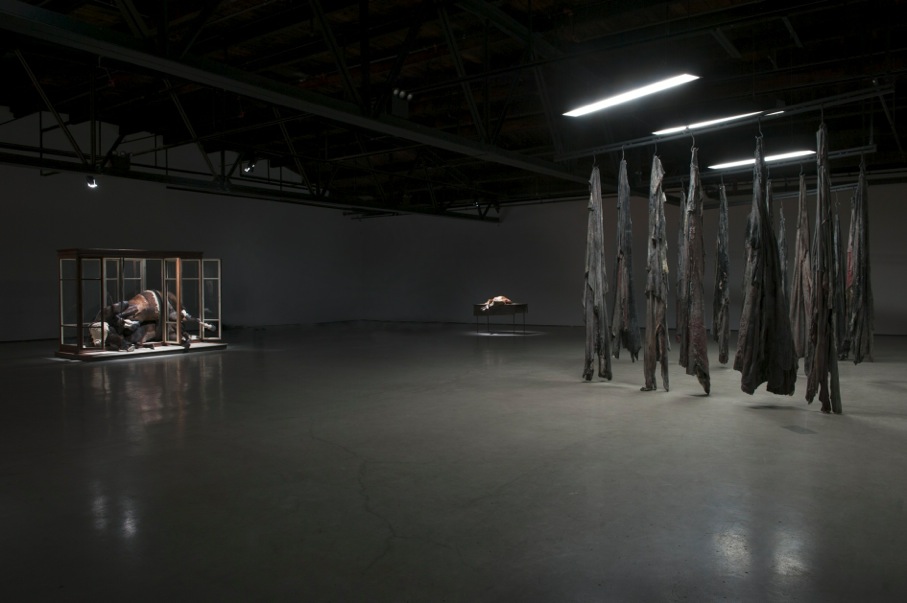
Berlinde De Bruyckere, No Life Lost, Installation view, (Right) No Life Lost 1, 2014-2015, Image courtesy of Hauser and Wirth, NY, 2016
There is a fine line in representation that is often reached but not crossed. It is the line from reality into non-reality, when something is so real in its’ portrayal that it awakens particular feelings (curiosity/abhorrence/joy) in the viewer. The premonition of that initial reaction can change once there is further comprehension that the object isn’t actual but has been fabricated. It’s the difference between the image of a person captured in a photograph and the person as they are in ‘real’ three-dimensional space. It is the difference between life and living, storytelling and fact, proposed truth versus undeniable truth. Looking at the tightly bound eyes of her horses, Fra Angelico’s ‘The Mocking of Christ‘ comes to mind, a fresco installed at the Convent of San Marco in Florence. Completed in 1442, the image is one of the most striking ever to be made and compositionally beyond its time. A masked figure, Christ sits in the center of the scene, as disembodied heads and hands gesture both referencing movement and illustrating the biblical story of the Passion. When blindfolded a subject normally exibits an association of shame, fear, and impending danger. However, the calming of the masked horses carries a deeper metaphor one that is as religious as it is political. In the masked figure of Christ by Fra Angelico, could we also be lead to believe in the serene depiction of the body that the figure was already in a state of tranquil acceptance even if the journey to get there was arduous? In both the contemporary masked body and the masked body of yore, fear can be associated with the concealment, yet looks can be deceiving.
Similar yet differently executed, Hermann Nitsch uses blood in his paintings and performances, a bold color and medium on environmental surfaces (body) along with linen canvas. The work is not easy to look at. In the performances, often an animal —pig— is splayed out and carried on what could be conceived to be a crucifix, while human participants are covered in blood. Upon first glance, one might question, “Did a death take place?” Indeed, at some point, however the artist himself was never involved in the death, or sacrifice. The pig was purchased, similar to how someone would buy a tube of paint or hunk of marble. In the human psyche, blood is often associated with violence and suffering, while Nitsch has used the liquid —once the purveyor of life— to symbolize just that; liberation of the spirit.
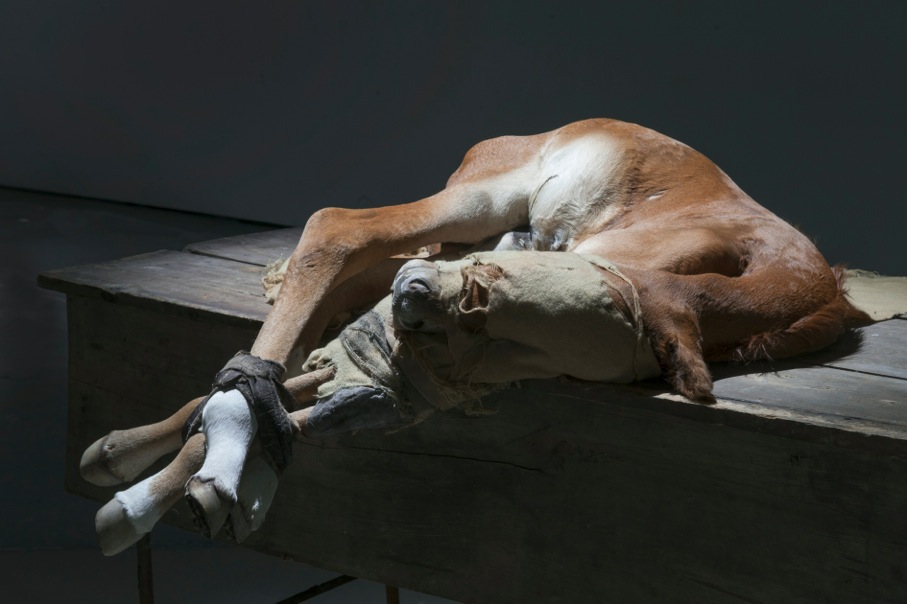
Berlinde De Bruyckere, to Zurbaran, 2015, Installation view, No Life Lost, Image courtesy of Hauser and Wirth, New York, 2016
Just as Nitsch longs to free the soul. Berlinde De Bruyckere longs to keep in a box and admire it, if only for a short while before letting it go. Another work worth mentioning in No Life Lost, is the tremendous Kreupelhout – Cripplewood, 2012-2013, which was also featured in the 2013 Biennale di Venezia at the Belgian pavilion. The sculpture is made of wax, epoxy, iron, wood, fabric, blankets and rope and stretches nearly 60 feet in length. It somehow embodies a fallen tree, beached whale, fleshy squid tentacles and tangled bones all at once. A year-long undertaking, the work had to be installed in various segments through the roof of the gallery. Similar to the sculptures with animal hides, this piece signifies a carcass, something living now in a state of stasis. It somehow is even stranger (or less complex) than the works made of pelts because it still resembles wood. The skeletal frame of a tree —bark it’s skin— wood plays a critical role in the physical presence and existence of a tree. In this case, it is the interior while the horse and cow hides are the exterior. In one body of work her canvas is exposed while in the other it is covered in thick impasto. The poeticism of Berlinde De Bruyckere’s work is not immediately accessible, it asks for more attention, which many viewers might not be ready to give. Yet with time, subtle nuances become more apparant, those of the artist’s hand and presence. Because even if no life has been lost, we are reminded of the longing of time needed to fulfill a life worth living.
……………………………………………………………………………………………………………………………………….
Berlinde De Bruyckere, No Life Lost is on view at Hauser and Wirth, New York until April 2nd, 2016. As part of the exhibition a series of performances by Romeu Runa will take place at the gallery on 18th street. Remaining performances will be held February 24th and 25th at 7pm and April 1st at 7pm and 2nd at 2pm.
……………………………………………………………………………………………………………………………………….
- Fra Angelico,The Mocking of Christ with the Virgin and St. Dominic, 1442 (fresco) Church of San Marco, Florence, Italy Italian, out of copyright
- Jannis Kounellis Senza titolo, 1989 quarti di bue su lastre metalliche Espai Poblenou, Barcellona (Courtesy of engramma.it)
- Hermann Nitsch, Performance detail, Orgien-Mysterien-Theater
More soon!
xo

